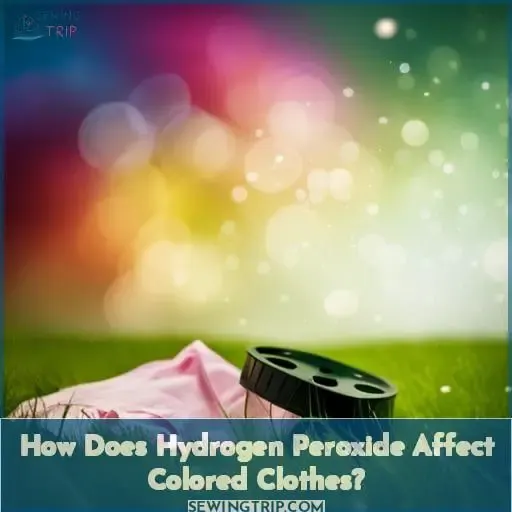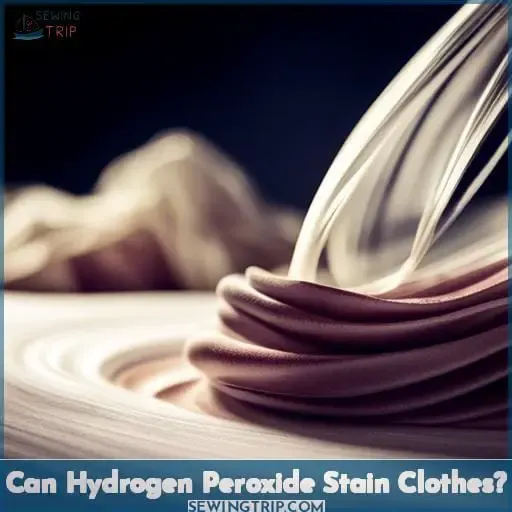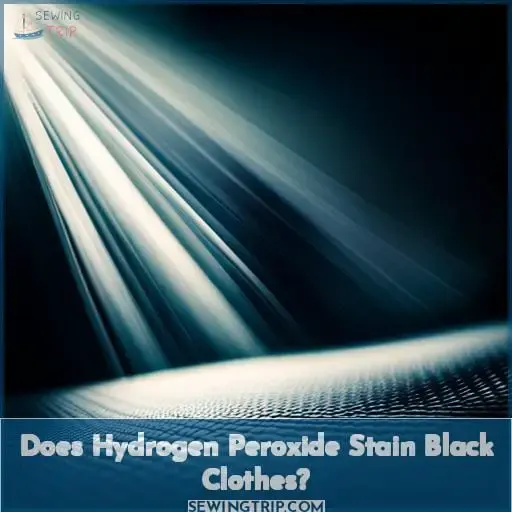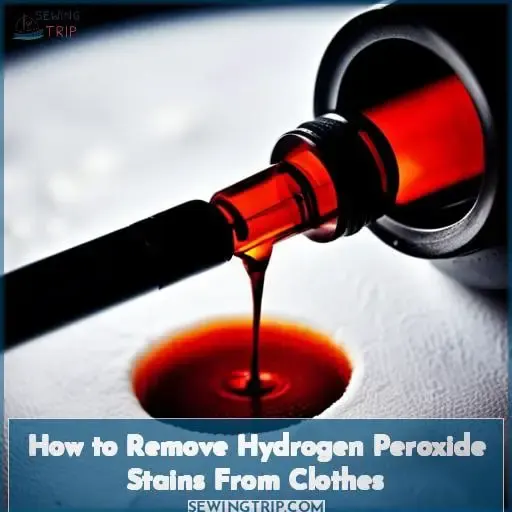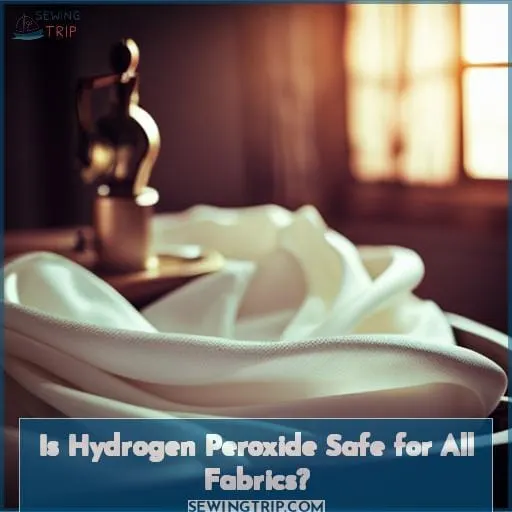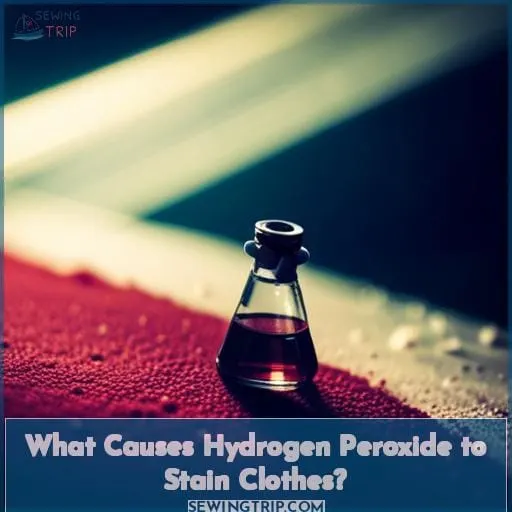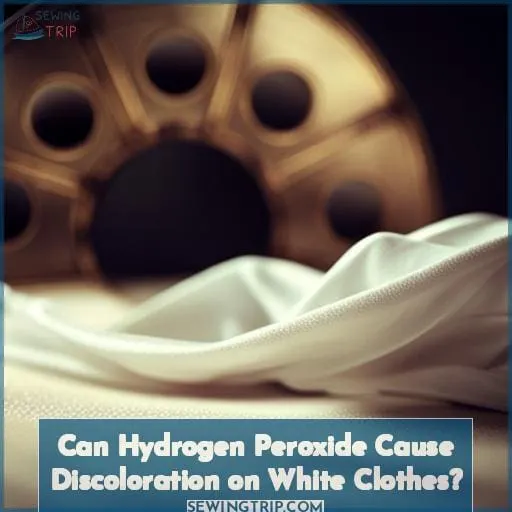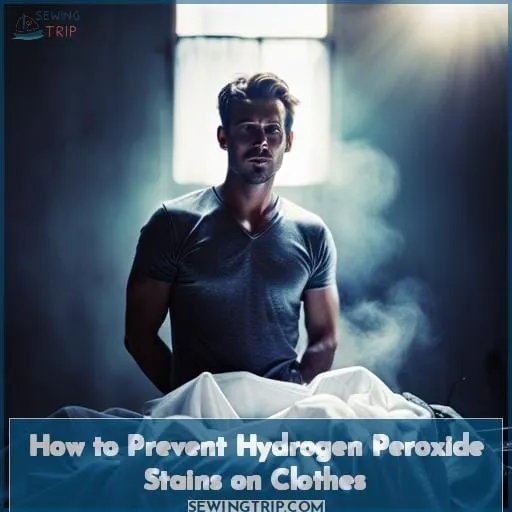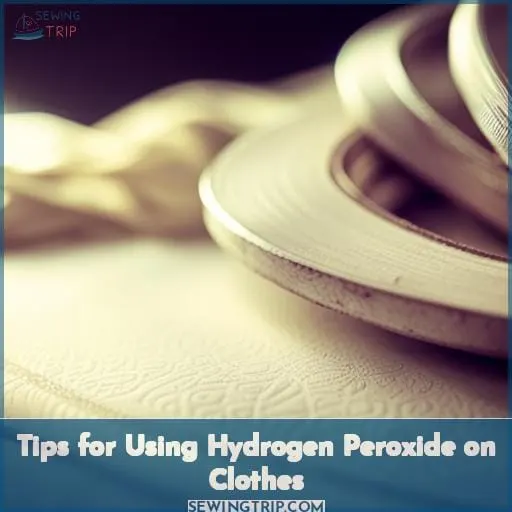This site is supported by our readers. We may earn a commission, at no cost to you, if you purchase through links.
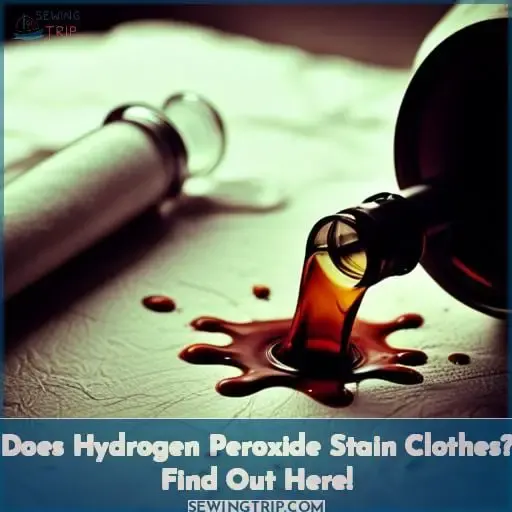 Imagine effortlessly removing stubborn stains from your favorite clothes without worrying about damaging them.
Imagine effortlessly removing stubborn stains from your favorite clothes without worrying about damaging them.
In this article, we’ll explore the question: Does hydrogen peroxide stain clothes?
As a laundry expert, I’m here to provide you with all the answers and insights you need. From understanding how hydrogen peroxide affects different fabrics to learning effective stain removal techniques, you’ll gain the power and knowledge to conquer any laundry challenge.
Get ready for liberation from pesky stains as we uncover the truth about hydrogen peroxide’s impact on your wardrobe!
Table Of Contents
- Key Takeaways
- How Does Hydrogen Peroxide Affect Colored Clothes?
- Can Hydrogen Peroxide Stain Clothes?
- Does Hydrogen Peroxide Stain Black Clothes?
- How to Remove Hydrogen Peroxide Stains From Clothes
- Is Hydrogen Peroxide Safe for All Fabrics?
- What Causes Hydrogen Peroxide to Stain Clothes?
- Can Hydrogen Peroxide Cause Discoloration on White Clothes?
- How to Prevent Hydrogen Peroxide Stains on Clothes
- Tips for Using Hydrogen Peroxide on Clothes
- Frequently Asked Questions (FAQs)
- Conclusion
Key Takeaways
- Potential color loss with hydrogen peroxide
- Importance of colorfastness testing
- Factors affecting staining and bleaching
- Safe fabrics for hydrogen peroxide use
How Does Hydrogen Peroxide Affect Colored Clothes?
When it comes to colored clothes, hydrogen peroxide can potentially cause color loss if not used properly.
To minimize any risk, it’s essential to test for colorfastness before using hydrogen peroxide on your garments.
Diluting the hydrogen peroxide with water and applying it carefully can help prevent unwanted bleaching or staining effects on colored fabrics.
Testing for Colorfastness
To determine the effect of hydrogen peroxide on colored clothes, you should first test for colorfastness.
Here are some important considerations when conducting colorfastness testing:
- Choose an inconspicuous area of the garment to perform the test.
- Apply a small amount of hydrogen peroxide to the fabric and let it sit for a few minutes.
- Gently blot with a clean white cloth and check for any signs of color loss or fading.
- If there’s no visible damage, proceed with caution when using hydrogen peroxide on your colored clothes.
Potential Color Loss
When testing hydrogen peroxide on colored clothes, be aware of the potential for color loss.
While hydrogen peroxide is generally safe for colored fabrics, there’s a risk of color fading or bleaching.
To avoid this issue, it’s crucial to test fabric colorfastness before using hydrogen peroxide as a stain remover.
Dilution techniques can also help minimize the staining risks and ensure that the fabric remains suitable for use after treatment.
Taking preventive precautions will help preserve your colored clothes during stain removal processes.
[ARTICLE TOOLS]:
- Bleach vs Hydrogen Peroxide: Which Is Better?
- Can You Mix Hydrogen Peroxide with Vinegar?
- How to Safely Remove Stains Using Hydrogen Peroxide
Dilution and Application Techniques
To avoid potential color loss, it’s important to dilute hydrogen peroxide properly and apply it carefully when treating colored clothes.
- Dilution Techniques:
- Mix hydrogen peroxide with water to lower its concentration before applying it on colored fabrics.
- Colorfast Testing:
- Always test a small, inconspicuous area of the fabric before treating the entire garment.
- Stain Prevention:
- Promptly rinse off any excess hydrogen peroxide from the fabric after treatment to prevent staining.
- Fabric Compatibility:
- Consider the type of fabric you’re dealing with as certain materials may react differently to hydrogen peroxide.
- Application Tips:
- Apply hydrogen peroxide directly onto stains using a spray bottle or by dabbing it gently with a cloth.
By following these guidelines, you can effectively use hydrogen peroxide as a stain remover without risking damage or discoloration to your colored clothing.
Can Hydrogen Peroxide Stain Clothes?
When it comes to using hydrogen peroxide on clothes, you may wonder if it can cause stains. While hydrogen peroxide is generally considered safe for most fabrics, there are some risks of staining that you should be aware of.
Factors such as the concentration of hydrogen peroxide and the type of fabric can affect whether or not staining occurs. However, by taking proper precautions and following guidelines for usage, you can minimize the risk and enjoy the benefits that hydrogen peroxide offers in laundry care.
Risks of Staining
If you’re wondering whether hydrogen peroxide can stain your clothes, it’s important to understand the risks involved.
While hydrogen peroxide is generally safe for fabrics, there’s a possibility of staining under certain conditions.
The staining mechanism occurs when the hydrogen peroxide reacts with dyes in fabric or if it remains on the fabric for an extended period without rinsing properly.
Black clothes may be particularly susceptible to discoloration.
To prevent stains, perform colorfast testing and ensure proper rinsing after stain soaking treatments.
Factors Affecting Staining
In the article ‘Does Hydrogen Peroxide Stain Clothes? Find Out Here!’, let’s explore the factors that can affect whether hydrogen peroxide stains clothes.
Colorfastness testing is crucial to determine if a fabric will be prone to staining.
Other staining factors include the concentration of hydrogen peroxide used, exposure time, and fabric type.
To prevent discoloration on black clothes or any other color, it’s important to take preventive precautions such as diluting hydrogen peroxide and prompt washing after treatment.
Precautions to Prevent Staining
To prevent staining when using hydrogen peroxide on clothes, you should take necessary precautions.
- Test colorfastness: Before applying hydrogen peroxide to a garment, test it on an inconspicuous area to ensure the fabric won’t be affected.
- Use dilution techniques: Dilute hydrogen peroxide with water before applying it to your white clothes.
- Promptly wash after treatment: After treating stains with hydrogen peroxide, wash the clothing promptly to minimize the risk of discoloration.
Does Hydrogen Peroxide Stain Black Clothes?
When using hydrogen peroxide on black clothes, it’s important to consider whether or not it will cause any staining.
Black clothes can be particularly susceptible to showing stains, so colorfastness testing is crucial before treating them with hydrogen peroxide.
While hydrogen peroxide can be an effective stain remover, there are some risks of staining when used on black fabrics.
The main concern is the potential for discoloration or lightening of the fabric due to the bleaching properties of hydrogen peroxide.
To prevent staining and damage, it’s essential to take preventive measures such as diluting the solution and applying it carefully only on specific stains rather than saturating the entire garment.
If a stain does occur from using hydrogen peroxide, prompt stain removal techniques should be employed for best results in minimizing residue and preserving fabric suitability.
How to Remove Hydrogen Peroxide Stains From Clothes
If you’ve accidentally stained your clothes with hydrogen peroxide, don’t worry! You can easily remove the stains using simple household ingredients.
- Colorfast Testing:
Before treating the stain, perform a colorfast test by applying a small amount of hydrogen peroxide on an inconspicuous area of the fabric. If there’s no color change or damage, proceed with stain removal.
- Blotting and Rinsing:
Start by blotting the stained area gently with a clean cloth or paper towel to absorb any excess liquid. Then, rinse the fabric under cold water to flush out as much of the hydrogen peroxide as possible.
- Stain Removal Solution:
Create a solution by mixing equal parts dish soap and warm water in a bowl or bucket. Apply this solution directly onto the stained area and use a soft-bristled brush or sponge to work it into the fabric.
- Drying and Washing:
After allowing enough time for it to penetrate through fibers, wash garment normally avoiding chlorine bleach if needed then air dry. Finally check for complete removal before repeating process
Is Hydrogen Peroxide Safe for All Fabrics?
When it comes to hydrogen peroxide and fabrics, it’s important to consider the suitability of different materials.
Hydrogen peroxide is generally safe for most fabrics, including cotton, linen, polyester blends, and synthetic fibers.
However, it may not be suitable for delicate or sensitive fabrics such as silk or woolen garments.
Always check the care label instructions before using hydrogen peroxide on your clothing to ensure compatibility with the fabric type.
Suitable Fabrics for Hydrogen Peroxide
If you’re wondering if hydrogen peroxide is safe for all fabrics, it’s important to consider the suitability of different fabric types.
Fabric compatibility is crucial when using hydrogen peroxide to avoid any potential discoloration risks.
Conduct colorfast testing on a small, inconspicuous area of the fabric before applying hydrogen peroxide to ensure that it won’t cause any unwanted staining or damage.
By taking these precautions and following proper application techniques, you can safely use hydrogen peroxide on suitable fabrics for stain prevention and odor removal purposes.
Fabrics to Avoid Using Hydrogen Peroxide On
You should generally avoid using hydrogen peroxide on delicate fabrics that are prone to damage.
Fabrics such as silk, wool, and satin can be sensitive to the bleaching properties of hydrogen peroxide and may experience discoloration or weakening of fibers.
It’s important to prioritize fabric compatibility when considering stain removal methods.
Always perform a colorfast test on an inconspicuous area before applying hydrogen peroxide to prevent potential discoloration or damage.
What Causes Hydrogen Peroxide to Stain Clothes?
Wondering why hydrogen peroxide sometimes leaves stains on your clothes?
The staining mechanism of hydrogen peroxide can be attributed to its bleaching properties. When hydrogen peroxide comes into contact with certain fabrics, it can react with the dye molecules and break them down, leading to discoloration or lightening of the fabric.
Factors such as concentration, exposure time, fabric type, and colorfastness play a role in determining whether or not hydrogen peroxide will stain your clothes.
Staining mechanism of hydrogen peroxide
When hydrogen peroxide comes into contact with certain fabrics, it can cause staining.
The staining mechanism of hydrogen peroxide involves its oxidizing properties, which react with the dyes and pigments present in the fabric. This reaction results in color changes or discoloration on the affected areas of clothing.
To prevent stains from occurring, it’s important to perform colorfast testing on a small inconspicuous area before using hydrogen peroxide for stain removal purposes. Additionally, taking preventive measures such as diluting hydrogen peroxide and prompt washing after treatment can help minimize the risk of fabric staining.
Factors affecting fabric staining
Continuing the discussion on the staining mechanism of hydrogen peroxide, let’s explore the factors that can contribute to fabric staining.
Factors such as colorfastness testing, suitable fabrics, and preventing staining are crucial in understanding why hydrogen peroxide may stain clothes.
Black clothes are particularly susceptible to stains from hydrogen peroxide due to their darker color.
To prevent staining and ensure effective stain removal, it’s important to choose appropriate fabrics and follow proper application techniques when using hydrogen peroxide for disinfecting or laundry purposes.
Preventing hydrogen peroxide stains
To avoid hydrogen peroxide stains on your clothes, take precautions to prevent excessive exposure and ensure proper application techniques.
- Conduct colorfast testing before using hydrogen peroxide on colored fabrics.
- Use a small amount of hydrogen peroxide for stain removal to minimize the risk of discoloration.
- Promptly rinse and wash treated clothing after stain removal to remove any residual hydrogen peroxide.
- Be cautious when treating delicate or sensitive fabrics with higher concentrations of hydrogen peroxide.
- Consider using alternative stain removers for fabrics that may be prone to staining.
Can Hydrogen Peroxide Cause Discoloration on White Clothes?
If you use hydrogen peroxide on white clothes, it can potentially cause discoloration. Preventing this is crucial to maintain the pristine appearance of your garments.
Before using hydrogen peroxide on white clothing, perform a colorfast test by applying a small amount of diluted solution to an inconspicuous area and checking for any adverse reactions.
To minimize the risk of staining, dilute the hydrogen peroxide with water before applying it to your clothes.
Additionally, consider pre-treating stains with a stain remover specifically designed for whites or oxygen-based bleaches before using hydrogen peroxide as part of your laundry routine.
When applying the solution onto fabrics, opt for spray application rather than soaking them entirely in order to prevent concentrated contact and potential discoloration issues.
How to Prevent Hydrogen Peroxide Stains on Clothes
To prevent hydrogen peroxide stains on clothes, it’s important to apply the solution properly.
- Make sure to pre-treat any stained areas with a small amount of hydrogen peroxide.
- Gently blot the stain before washing.
- Additionally, always test the solution on an inconspicuous area of the fabric first to ensure colorfastness.
- Promptly wash your clothes after treatment to prevent any residual hydrogen peroxide from causing discoloration or damage.
Proper Application Techniques
To prevent hydrogen peroxide stains on your clothes, follow proper application techniques.
- Before treating a stain with hydrogen peroxide, perform colorfastness testing on an inconspicuous area of the fabric to ensure it won’t cause discoloration.
- Dilute the hydrogen peroxide with water according to fabric suitability and apply it directly to the stain using a spray nozzle or cotton swab.
- Allow it to soak for about 10 minutes before washing as usual to effectively remove stains without risking discoloration.
Pre-treating and Testing
Before applying hydrogen peroxide to your clothes, it’s important to take proper pre-treating and testing measures to prevent any potential stains.
Begin by conducting a colorfastness check on an inconspicuous area of the fabric.
Dilute the hydrogen peroxide with water before applying it to the stain for gentle yet effective stain removal.
Ensure fabric safety by avoiding prolonged exposure and promptly washing treated garments after treatment.
These precautions will help you prevent hydrogen peroxide stains on your clothes while maintaining their quality and appearance.
Prompt Washing After Treatment
After pre-treating a stain with hydrogen peroxide, it’s important to promptly wash the treated garment to prevent any potential hydrogen peroxide stains.
Prompt washing helps minimize the risk of staining and ensures that your clothes come out clean and fresh.
Before washing, conduct colorfastness testing on a small, inconspicuous area of the fabric to ensure that it won’t be affected by the hydrogen peroxide.
Dilute any remaining traces of hydrogen peroxide in water before adding them to your laundry load for preventive precautions against stains.
Tips for Using Hydrogen Peroxide on Clothes
When using hydrogen peroxide on clothes, it’s important to employ effective stain removal techniques.
- Apply a small amount of hydrogen peroxide directly onto the stain.
- Let it sit for about 10 minutes before laundering as usual.
Avoid overexposure by testing the fabric’s reaction in an inconspicuous spot beforehand, especially with higher concentrations.
Additionally, remember to store your hydrogen peroxide in a cool and dark place to maintain its effectiveness throughout its shelf life.
Effective Stain Removal Techniques
Get rid of stubborn stains on your clothes with these effective tips for using hydrogen peroxide.
Before applying it to your garments, always conduct a colorfastness test to ensure the fabric’s suitability.
To remove stains, apply a small amount of hydrogen peroxide directly onto the affected area and let it soak for about 10 minutes before washing as usual.
These stain removal techniques will help you maintain clean and vibrant clothes without any worry of discoloration or staining caused by hydrogen peroxide.
Avoiding Overexposure to Hydrogen Peroxide
To avoid overexposure to hydrogen peroxide while using it on clothes, take the following precautions:
- Before applying hydrogen peroxide, always perform a colorfast test on a small inconspicuous area of the fabric to ensure it won’t cause any discoloration.
- When treating stains, apply only a small amount of hydrogen peroxide and let it soak for about 10 minutes before washing as usual.
- Promptly wash treated clothing to minimize any potential staining or fabric damage.
By taking these steps, you can prevent staining and ensure the safety of your fabrics when using hydrogen peroxide in laundry care.
Storage and Shelf Life Considerations
Make sure to store your hydrogen peroxide in a cool, dark place to maximize its shelf life and effectiveness.
Proper storage is essential for maintaining the quality of your hydrogen peroxide over time.
Additionally, it’s crucial to conduct fabric testing and colorfastness testing before using hydrogen peroxide on clothes.
This will help prevent stains or color loss and ensure that the stain removal process is successful without damaging your garments.
By following these tips, you can confidently use hydrogen peroxide for stain removal without worrying about any adverse effects on your clothes’ appearance or longevity.
Frequently Asked Questions (FAQs)
Can hydrogen peroxide stain colored clothes?
Hydrogen peroxide can potentially stain colored clothes.
If used in high concentrations or left on fabric for too long.
Test it first on an inconspicuous area to check for colorfastness.
Dilute with water to prevent staining.
How do you remove hydrogen peroxide stains from clothes?
Looking to remove hydrogen peroxide stains from your clothes? No worries, we’ve got you covered.
Simply treat the stained area with a mixture of water and mild detergent, then wash as usual.
Say goodbye to those pesky stains!
Is hydrogen peroxide safe for all types of fabrics?
Hydrogen peroxide is generally safe for all types of fabrics. However, it’s always recommended to test it on a small, inconspicuous area first to ensure there are no adverse reactions or color loss.
Can hydrogen peroxide cause discoloration on white clothes?
Hydrogen peroxide, the laundry superhero, won’t let your white clothes lose their radiance. With its powerful stain-fighting abilities and gentle nature, it prevents discoloration while keeping you stylishly liberated from dullness.
What are some tips for using hydrogen peroxide on clothes?
To ensure successful use of hydrogen peroxide on clothes, dilute it with water and test for colorfastness.
Apply the solution directly to stains using a spray nozzle or cotton swab, allowing it to soak before washing.
Conclusion
In your quest for stain-free clothes, you may wonder, Does hydrogen peroxide stain clothes? Fortunately, hydrogen peroxide can be an effective stain remover without causing permanent damage to most fabrics.
- Testing for colorfastness
- Diluting properly
- Prompt washing after treatment
By following these tips and techniques, you can confidently use hydrogen peroxide to tackle stubborn stains and keep your wardrobe looking fresh and vibrant.

